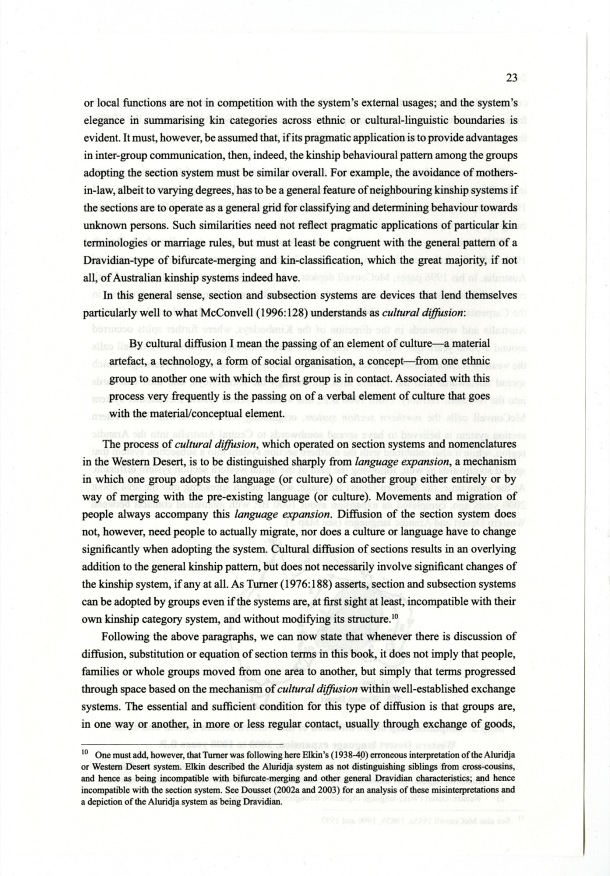|
| 
[Note: this transcription was produced by an automatic OCR engine]
23
or local functions are not in competition with the system’s external usages; and the system’s
elegance in summarising kin categories across ethnic or cultural-linguistic boundaries is
evident. It must, however, be assumed that, if its pragmatic application is to provide advantages
in inter-group communication, then, indeed, the kinship behavioural pattern among the groups
adopting the section system must be similar overall. For example, the avoidance of mothers-
in-law, albeit to varying degrees, has to be a general feature of neighbouring kinship systems if
the sections are to operate as a general grid for classifying and determining behaviour towards
unknown persons. Such similarities need not reflect pragmatic applications of particular kin
terminologies or marriage rules, but must at least be congruent with the general pattern of a
Dravidian-type of bifurcate-merging and kin-classification, which the great majority, if not
all, of Australian kinship systems indeed have.
In this general sense, section and subsection systems are devices that lend themselves
particularly well to what McConvell 1996: 128 understands as cultural diflixsian:
By cultural diffusion I mean the passing of an element of culture—a material
artefact, a technology, a form of social organisation, a concept—from one ethnic
group to another one with which the first group is in contact. Associated with this
process very frequently is the passing on of a verbal element of culture that goes
with the material/conceptual element.
The process of cultural dzflitsion, which operated on section systems and nomenclatures
in the Western Desert, is to be distinguished sharply from language expansion, a mechanism
in which one group adopts the language or culture of another group either entirely or by
way of merging with the pre-existing language or culture. Movements and migration of
people always accompany this language expansion. Diffusion of the section system does
not, however, need people to actually migrate, nor does a culture or language have to change
significantly when adopting the system. Cultural diffusion of sections results in an overlying
addition to the general kinship pattern, but does not necessarily involve significant changes of
the kinship system, if any at all. As Turner 1976: 188 asserts, section and subsection systems
can be adopted by groups even if the systems are, at first sight at least, incompatible wit.l1 their
own kinship category system, and without modifying its structure.”
Following the above paragraphs, we can now state that whenever there is discussion of
diffusion, substitution or equation of section terms in this book, it does not imply that people,
families or whole groups moved from one area to another, but simply that terms progressed
through space based on the mechanism of cultural diflixsion within well-established exchange
systems. The essential and sufficient condition for this type of diffusion is that groups are,
in one way or another, in more or less regular contact, usually through exchange of goods,
1° One must add, however, that Turner was following here Elkin‘s 1938-49 erroneous interpretation of the Aluridja
or Western Desert system. Elkin described the Aluridja system as not distinguishing siblings from cross-cousins,
and hence as being incompatible with bifurcate-merging and other general Dravidian characteristics; and hence
incompatible with the section system. See Dousset 2002a and 2003 for an analysis of these misinterpremtions and
a depiction of the Aluridja system as being Dravidian.
|